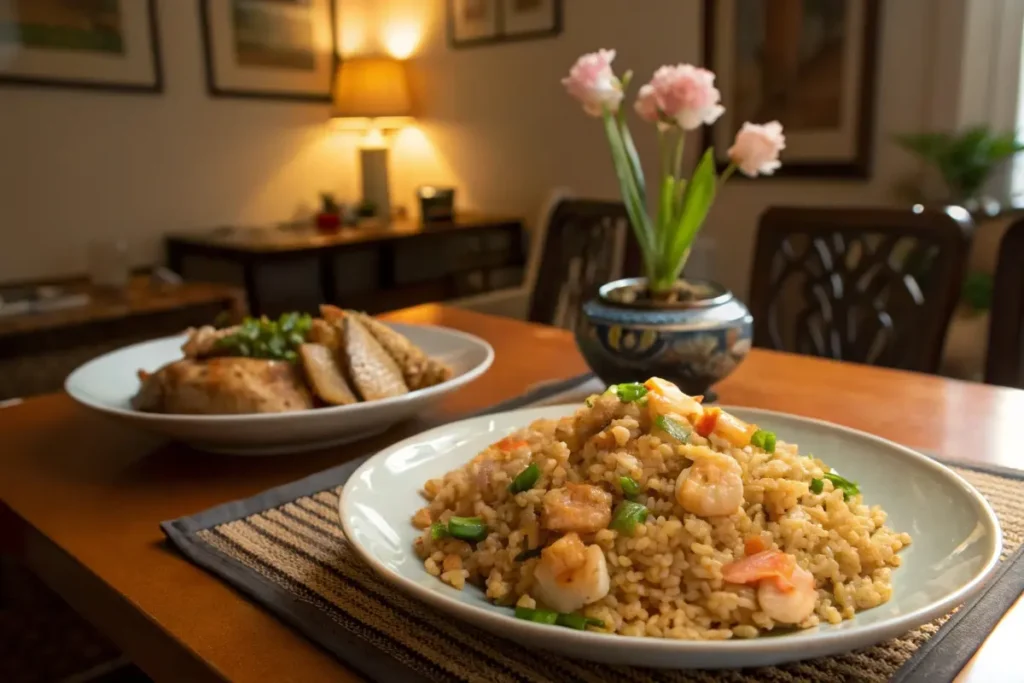If you’ve ever walked into a Japanese steakhouse and marveled at the tantalizing aroma of sizzling rice on a flat-top grill, then japanese fried rice recipe is undoubtedly on your culinary bucket list. From the iconic “egg show” performed by hibachi chefs to the irresistible combination of savory seasonings, this dish promises layers of flavor and endless customization. But what makes Japanese fried rice different? Unlike its Chinese counterpart, Japanese fried rice typically uses short-grain rice, subtle flavor enhancers like mirin or sake, and sometimes the signature “hibachi sauce” that ties everything together.
Before we dive into each step, let’s look at the essence of japanese restaurant style fried rice. It’s a harmony of chewy rice, tender proteins, and crisp vegetables, all brought together with soy sauce, butter, and sometimes a small amount of garlic or sesame oil. If you’re searching for more ways to bring Japanese flavors into your kitchen, don’t forget to check our Japanese Chicken Fried Rice Recipe for another delicious variation. Let’s delve into the secrets of hibachi fried rice and uncover how to recreate that unforgettable steakhouse taste right at home.
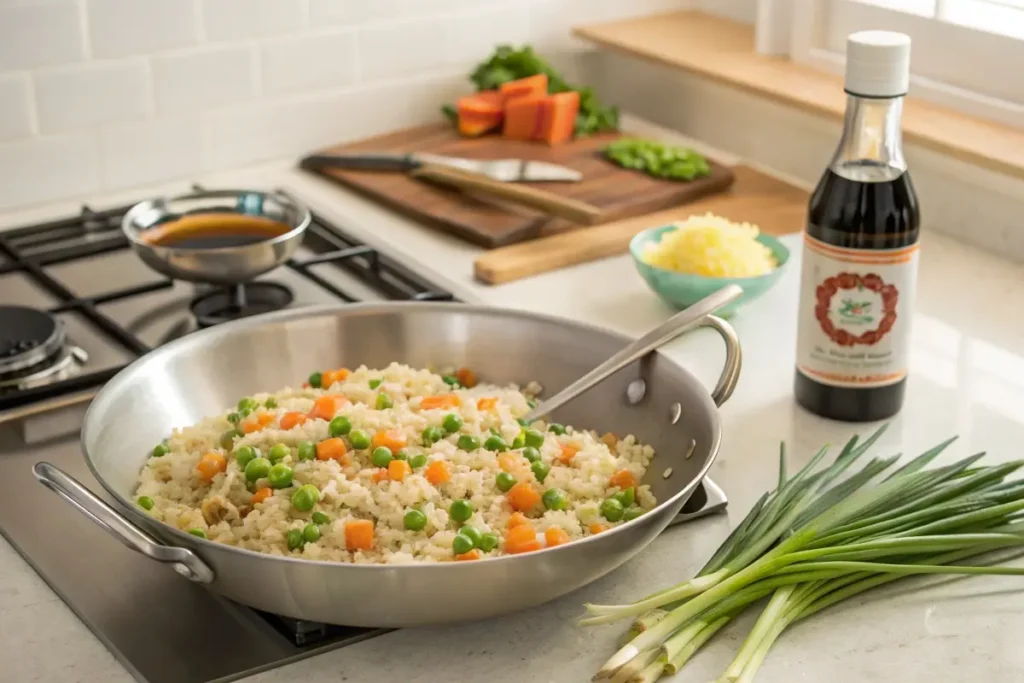
The Fundamentals of Japanese Fried Rice
To truly master a japanese fried rice recipe, it’s essential to understand the building blocks that set it apart from other types of fried rice. Below are the fundamental components and techniques that elevate this dish to a hibachi chef’s standards.
1. Short-Grain Rice is Key
When pondering how to make Japanese fried rice, the choice of rice is crucial. Short-grain rice, often referred to as sushi rice, has a stickier consistency. This helps the dish clump slightly while retaining individual grains. However, day-old rice is ideal because it dries out a bit, preventing a mushy texture during stir-frying.
Pro Tip: For authentic results, use Japanese Short-Grain Rice. Its chewy texture captures the flavors perfectly, just like in a Japanese steakhouse.
- Why it Matters: The texture of short-grain rice allows sauces and butter to coat each grain evenly, creating that signature Japanese steakhouse flavor.
2. Classic Seasonings
- Soy Sauce: Typically light or regular soy sauce is used, but watch your measurements—Japanese fried rice relies on subtlety rather than heavy salting.
- Mirin or Sake: Add a delicate sweetness and depth, reflecting a hallmark of Japanese cuisine.
- Authentic Flavor: Use Japanese Soy Sauce and a splash of Mirin to recreate the subtle sweetness and umami typical of hibachi fried rice.
- Butter: Often, a tablespoon or two of butter is added at the end to deliver a rich taste. This is often the answer to What do hibachi chefs squirt on rice? They often drizzle a combination of oil, soy sauce, and sometimes melted butter.
3. Proteins and Vegetables
Japanese fried rice can incorporate shrimp, chicken, beef, or remain vegetarian:
- Proteins: Bite-sized pieces of chicken, thinly sliced steak, or shrimp are common.
- Vegetables: Onions, peas, carrots, and scallions add color, sweetness, and crunch.
4. Cooking Techniques
- High Heat Cooking: Hibachi chefs use scorching-hot griddles. At home, opt for a wok or wide skillet that can reach and maintain high temperatures.
- At-Home Setup: A durable Hibachi-Style Griddle Pan or a wide Carbon Steel Wok helps you achieve that sizzling restaurant texture.
- Proper Sequencing: Cook proteins first, remove them, then stir-fry veggies. After that, add rice, sauce, and finally reintroduce proteins.
- Egg Integration: Some prefer mixing scrambled egg throughout the rice; others cook the egg first, slice it, and add back at the end for distinct pieces.
5. Balancing Flavors
Hibachi fried rice stands out for its delicate but distinctive seasoning. Unlike Chinese fried rice, which may rely on stronger sauces or sesame oil, Japanese variants keep it light yet flavorful—allowing each ingredient to shine. This approach is one of the reasons Why is hibachi fried rice so much better? It’s about balance: umami from soy sauce, richness from butter, and sweetness from the vegetables and mirin.
If you’re excited by how Japanese cuisine meticulously balances flavors, explore our Vegetables Japanese Recipe for ways to enhance produce with minimal seasoning. These techniques will help you become more confident in adjusting flavors to perfect your fried rice.
Selecting the Best Ingredients
A standout japanese steakhouse fried rice recipe hinges on choosing the right ingredients. While you can adapt the dish based on what you have on hand, certain items truly capture that hibachi flair.
1. Best Rice for Hibachi
- Short-Grain White Rice: Sushi rice or short-grain Japanese rice is the go-to. The starch content helps it stick together, but not overly so.
- Day-Old Rice: Refrigerate cooked rice overnight, so it dries slightly, preventing clumping and sogginess during stir-fry.
2. Protein Choices
- Chicken: Thighs are juicier, but breast works if you prefer lean meat.
- Beef: Thinly sliced steak or leftover roast beef can deliver that teppanyaki vibe.
- Shrimp: Quick to cook and pairs excellently with the sweet-salty flavors.
- Tofu: For a vegetarian spin, choose firm tofu; press and cube it for best results.
3. Vegetable Medley
A typical japanese restaurant style fried rice includes onions, carrots, peas, and green onions. However, feel free to add corn, mushrooms, or bell peppers. The key is to dice everything uniformly, ensuring even cooking.
4. Sauces and Seasonings
- Soy Sauce: Choose a Japanese brand for an authentic taste. The difference in sweetness and salt levels can be noticeable.
- Mirin or Rice Wine: Adds a mild sweetness and depth. If unavailable, a pinch of sugar with sake can substitute.
- Garlic and Ginger: Freshly minced or ground for an aromatic boost.
- Butter: Typically unsalted is used, so you can control the sodium level.
5. Optional Flavor Boosters
- Sesame Oil: A few drops can add a nutty aroma, but use sparingly to avoid overpowering other flavors.
- Hibachi Sauce: Some chefs make a light sauce combining soy sauce, butter, and a splash of sake or vinegar. They’ll often drizzle it directly on the cooking surface.
Shopping and Storage Tips
- Rice Storage: Stock up on short-grain rice if you enjoy frequent Japanese meals. Store it in a cool, dry place to maintain freshness.
- Protein Prep: If using chicken or beef, marinate lightly in soy sauce and ginger for about 15 minutes beforehand for enhanced flavor.
- Vegetable Prep: Dice carrots and onions in uniform sizes; freeze peas or corn can reduce prep time.
Once you’ve gathered these ingredients, you’re well on your way to creating that iconic smoky, caramelized essence. If you need ideas for a protein-packed side dish, you might pair your fried rice with our Japanese Steak Recipe for a hearty meal reminiscent of a real Japanese steakhouse experience.
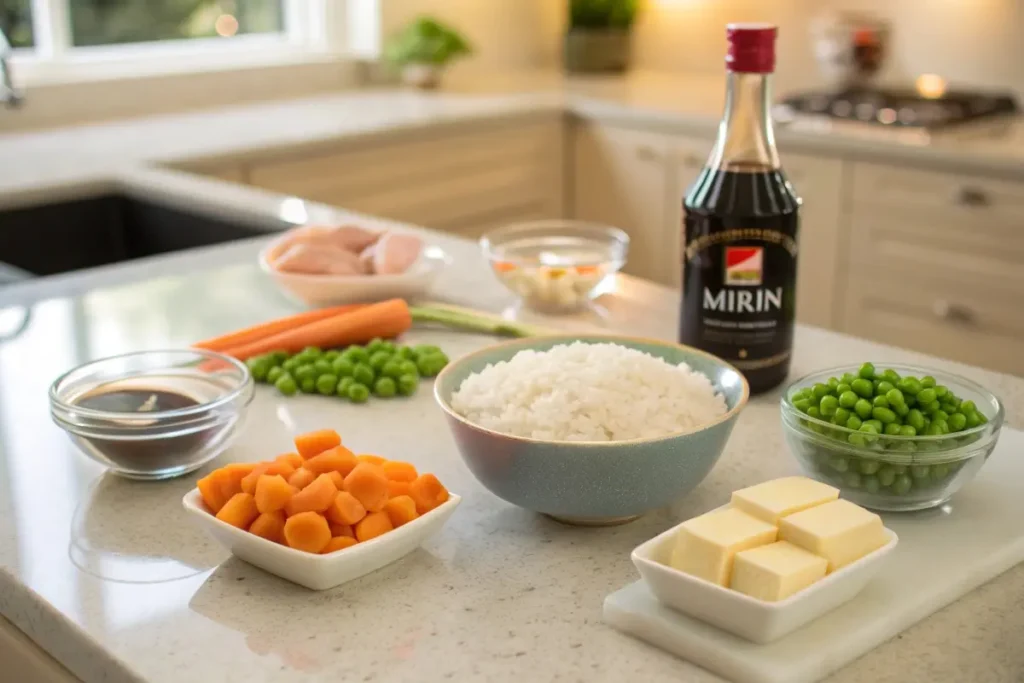
Step-by-Step Cooking Process
Curious how to make fried rice like Kobe or replicate the flair of a hibachi chef? Follow this streamlined approach to achieve restaurant-quality results in your home kitchen.
1. Prep Your Ingredients
- Rice: If you haven’t already prepared day-old rice, cook fresh rice and spread it on a tray or baking sheet to cool. Room-temperature or chilled rice is best.
- Chop & Measure: Dice onions, carrots, and any other vegetables into bite-sized pieces. Mince garlic and ginger if you’re using them. Measure out soy sauce, mirin, and butter.
2. Heat the Pan
- Choose a Large Skillet or Wok: A wide surface area ensures even frying. Hibachi chefs rely on large griddles for this reason.
- High Heat: Turn the burner to medium-high or high, and add a tablespoon of oil with a high smoke point, such as canola or vegetable oil.
- Chef’s Tool: A sturdy Teppanyaki Spatula Set makes stir-frying easier and brings that authentic hibachi flair to your kitchen.
3. Cook Proteins First
- Season & Sear: If you’re using chicken, steak, or shrimp, lightly season it with salt, pepper, and a splash of soy sauce.
- Brown on All Sides: Cook thoroughly until the proteins are golden. Transfer them to a plate and set aside.
4. Sauté Vegetables
- Add More Oil if Needed: The pan should remain lightly coated.
- Onions & Carrots First: These take longer, so stir-fry for about 2-3 minutes until onions become translucent.
- Peas & Other Quick-Cooking Veggies: Add them next, stirring for 1-2 minutes. Season lightly with a pinch of salt.
5. Incorporate Rice and Flavors
- Break Up the Rice: Add the chilled or leftover rice to the pan, using a spatula to separate clumps.
- Add Soy Sauce & Mirin: Drizzle evenly, stirring quickly to distribute flavor.
- Reintroduce Proteins: Return your cooked protein to the mixture.
- Butter or Hibachi Sauce: Stir in a tablespoon or two of butter, letting it melt and coat the grains. If you have a custom hibachi sauce (like a mixture of soy sauce, garlic, and sake), drizzle it now for an extra punch.
6. Egg Integration
- Option 1 (Scramble First): Move rice aside, crack an egg directly into the pan, scramble, then mix it into the rice.
- Option 2 (Separate Scramble): Cook the egg in a different pan, cut into pieces, and fold in at the end.
7. Final Touches
- Green Onions & Sesame Seeds: For garnish and extra color.
- Taste Test: Adjust soy sauce, salt, or pepper if necessary.
8. Serve Immediately
Japanese fried rice is best eaten fresh off the pan. If you’re aiming for that smoky “wok hei” effect, your cooking temperature should remain high. For additional nuance, you can also incorporate a dash of Japanese Barbecue Sauce toward the end, blending sweet and tangy layers into your rice.
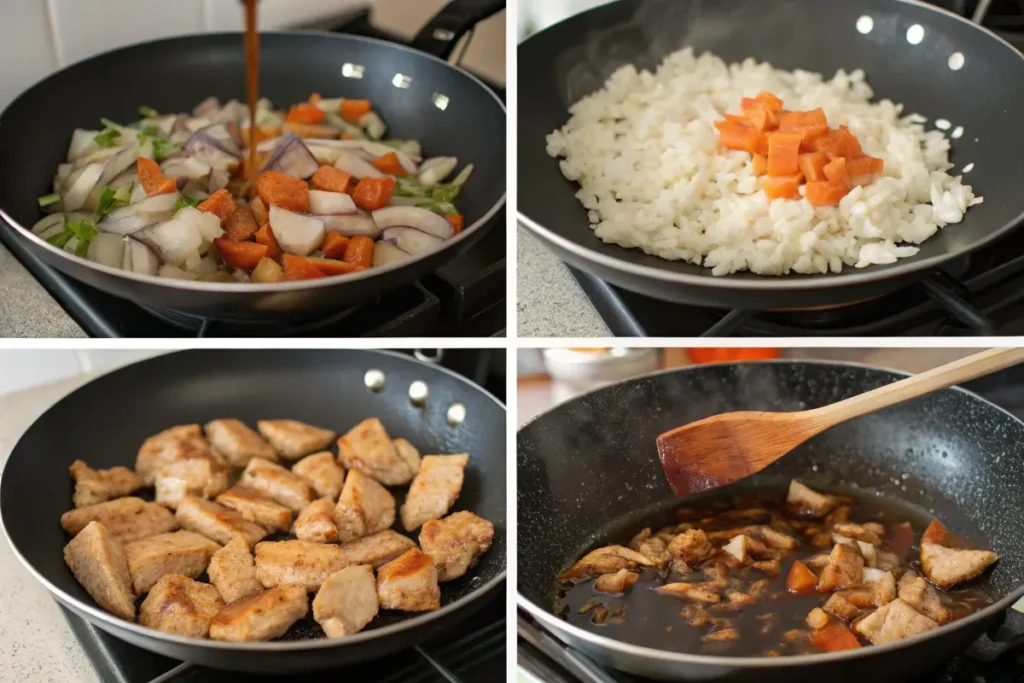
Elevating Your Japanese Fried Rice
After mastering the basics of a japanese fried rice recipe, you might want to explore creative ways to elevate your dish. Below are a few suggestions to add more complexity and flair, replicating that steakhouse allure or customizing it for personal preferences.
1. Hibachi Sauce Variations
- Garlic Butter: Some hibachi chefs mince garlic, mix it with softened butter, and use it generously during cooking. This rich infusion is part of Why is hibachi fried rice so much better?
- Ginger Sauce: A tangy blend of grated ginger, soy sauce, vinegar, and a bit of onion can be drizzled on top or served alongside the rice.
- Sweet & Spicy Glaze: Combine honey or sugar with a splash of chili sauce and soy, then toss this into your fried rice for a sweet heat.
2. Additional Toppings
- Tenkasu (Tempura Bits): These crunchy tidbits add texture and a subtle fried flavor.
- Bonito Flakes: If you enjoy a bit of seafood essence, sprinkle dried bonito flakes on the final dish for an umami kick.
- Pickled Ginger (Beni Shoga): Commonly served with Japanese dishes, it can lend a tangy punch and a vibrant pink color to your plate.
Hibachi Experience: Many diners enjoy finishing their fried rice with Yum Yum Sauce or a zesty Kewpie Japanese Onion Dressing with Garlic. They add a creamy or tangy contrast to the savory rice.
3. Experimenting with Additional Proteins
- Fish or Seafood: Beyond shrimp, consider scallops or small chunks of salmon. Refer to our Japanese Scallop Recipe for pairing ideas that adapt seamlessly to fried rice.
- Teriyaki Flavors: Marinate chunks of chicken in teriyaki sauce before stir-frying to fuse sweet-savory layers into the rice.
- Bacon or Ham: Not traditionally Japanese, but these can lend a smoky note reminiscent of Western fusion “Japanese steakhouse” styles.
4. Vegetarian and Vegan Adaptations
- Tofu & Vegetables: Swap meat for firm tofu. Sauté tofu cubes until lightly crisp, then add to the rice.
- Seaweed & Mushrooms: Dried seaweed strips or finely chopped mushrooms provide that meaty texture and umami without animal protein.
- Sauce Substitutions: Use tamari (gluten-free soy sauce) or vegan “fish sauce” alternatives. Check out our Vegan Japanese Recipes for comprehensive ideas.
5. Presentation and Serving Suggestions
- On a Hibachi Plate: Serve your fried rice on a large platter, garnished with thinly sliced green onions.
- With Miso Soup or Salad: Emulate the restaurant experience by pairing it with a side salad dressed in ginger dressing or a bowl of warm miso soup.
- Family-Style: Place a big bowl of fried rice at the center of the table with multiple serving spoons—great for casual gatherings.
By integrating these enhancements, you’ll discover new dimensions in taste and texture each time you whip up a batch of fried rice. If you’re curious about pairing your meal with a sweet ending, consider our Traditional Japanese Desserts Recipe to complete your dinner with a hint of authentic Japanese sweetness.
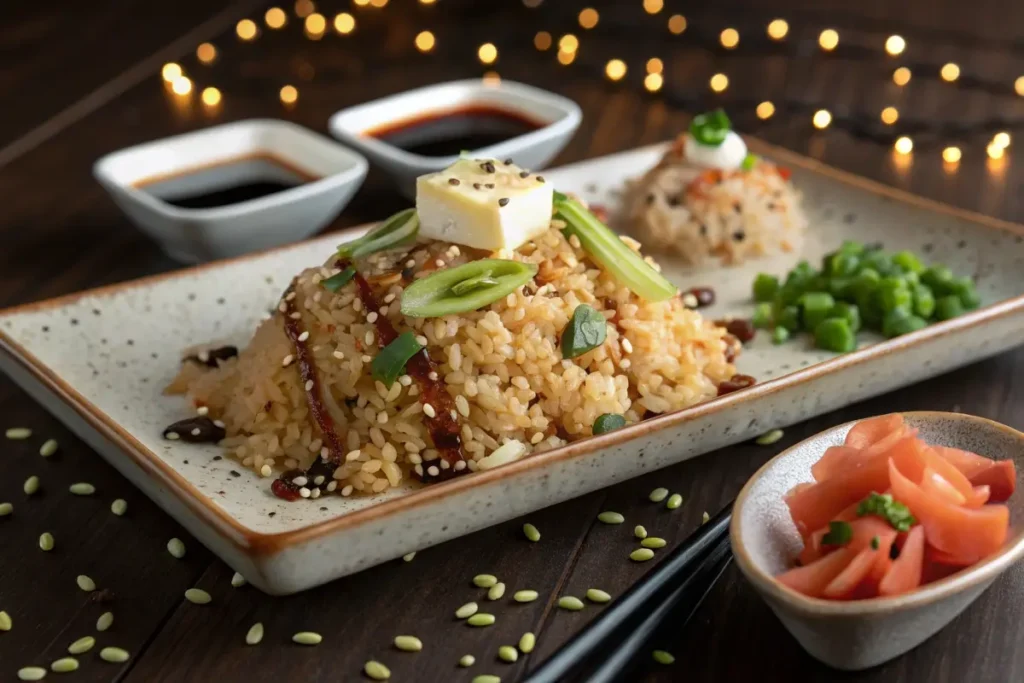
History and Context of Japanese Fried Rice
Although japanese fried rice recipe may seem like a modern invention—particularly the hibachi grill theatrics—its roots stretch back through centuries of culinary evolution. Understanding how fried rice became woven into Japanese cuisine enriches your appreciation of the dish.
Chinese Influence
Fried rice was originally popularized in China’s Sui dynasty (6th–7th century) and spread across Asia. Various cultures adapted it to local tastes, incorporating regional ingredients and seasonings. In Japan, Chinese immigrants and traders introduced stir-frying techniques and the concept of mixing leftover rice with small pieces of meat and veggies.
Adaptation in Japan
Over time, the Japanese palate shaped fried rice into a distinctly local dish. Short-grain Japanese rice replaced the typically medium-grain Chinese rice. The result was a slightly sticky texture, well-suited to the marinade-heavy cooking that typifies Japanese cuisine.
- Yakiniku and Teppanyaki: As Japan’s food culture modernized, open-griddle cooking gained popularity, especially after the post-World War II era. Teppanyaki restaurants spurred the idea of customizing your fried rice on a hot iron plate.
- Rise of Yoshoku: “Yoshoku” describes Western-inspired dishes in Japan, like omurice (rice wrapped in an omelet). Hibachi or teppanyaki fried rice can be seen as an extension of this cross-cultural melding, where soy sauce meets butter, and veggies are diced small to cook quickly on high heat.
Restaurant Culture
By the 1960s, the showy style of hibachi cooking—where chefs juggle utensils, crack eggs mid-air, and flambé onions—captivated diners. Japanese fried rice found a starring role in these performances, with chefs skillfully tossing soy sauce and spatulas, culminating in a flamboyant finishing flourish.
- International Appeal: Soon, large franchises adapted hibachi cooking for global audiences. Diners worldwide grew enamored with the taste of slightly sweet, buttery rice that pairs well with grilled meats and dipping sauces.
- Local Variations: Each Japanese steakhouse or teppanyaki restaurant might have a slight variation, be it extra garlic, a special “secret sauce,” or the addition of succulent shrimp. This variety keeps fans coming back to compare flavors.
Modern Takes
Today, you’ll find countless interpretations of Japanese fried rice, from homemade renditions to chain restaurants. Some chefs incorporate mayonnaise or spicy chili sauce for a fusion twist. Others keep it minimalistic, highlighting the purity of short-grain rice and fresh vegetables. With the popularity of cooking videos and culinary blogs, the dish has gained a massive online following. By reading articles like this or exploring our Japanese Recipes page, you continue the tradition of sharing and adapting a beloved global staple.

Practical Examples/Use Cases
Implementing a japanese fried rice recipe in your routine can go beyond a quick weeknight dinner. Below are several practical scenarios illustrating how this dish can adapt to diverse needs.
1. Family Dinner Staple
- Scenario: You need a dish that pleases both kids and adults.
- Implementation: Cook a large batch of fried rice on Sunday. Reheat portions on busy weeknights. Customize protein for each family member—chicken for the kids, shrimp or tofu for the vegetarians.
- Benefit: Quick, wholesome, and easy to scale up.
2. Potluck or Party
- Scenario: Attending a get-together and want something crowd-pleasing.
- Implementation: Prepare a big tray of hibachi fried rice. Keep it warm in an insulated container or slow cooker. Garnish with green onions and sesame seeds for a finishing touch.
- Benefit: Fried rice travels well, stays delicious at room temperature, and the mild yet savory flavor appeals to many palates.
3. Meal Prep for Work Lunches
- Scenario: You need a portable lunch option that reheats well.
- Implementation: Make a double portion, and pack individual servings in microwave-safe containers. Add a side of pickled ginger or a small packet of soy sauce for quick flavor boosts.
- Benefit: Saves time on busy mornings, prevents midday fast-food temptations, and offers a balanced meal rich in protein and vegetables.
4. Leftover Makeover
- Scenario: You have leftover rice, cooked chicken, or sautéed vegetables.
- Implementation: Transform these leftovers into fresh fried rice by stir-frying with a splash of soy sauce, a knob of butter, and extra garlic.
- Benefit: Reduces food waste while creating a brand-new meal in minutes.
5. Brunch Twist
- Scenario: Hosting a laid-back weekend brunch.
- Implementation: Serve Japanese fried rice alongside eggs Benedict or an omelet. The savory profile pairs well with lighter brunch items.
- Benefit: Provides a cross-cultural spread that wows guests, blending classic breakfast foods with an Asian-inspired dish.
For more diverse recipes that mesh well with fried rice, check out our Minced Beef Japanese Recipe to see how easy it is to fuse new proteins into an already adaptable platform.

FAQs
Below are some common questions that arise when people explore a japanese fried rice recipe at home.
- What makes Japanese fried rice different?
Japanese fried rice typically uses short-grain rice, which is stickier and more compact. This allows the flavors—like soy sauce, butter, and mirin—to coat each grain evenly. Chinese fried rice often uses long-grain rice, resulting in a lighter, less sticky texture. - What do hibachi chefs squirt on rice?
Chefs commonly use a mixture of soy sauce, oil (like vegetable or canola), and sometimes melted butter. Some also add garlic-infused oil or sake for extra flavor. - Why is hibachi fried rice so much better?
Hibachi fried rice benefits from high-heat cooking on a large flat grill, enabling quick evaporation of moisture and slight caramelization of ingredients. The addition of butter or a specific “hibachi sauce” also imparts a richer, more indulgent taste than standard fried rice.
How to make fried rice like Kobe?
- Kobe-style fried rice often includes finely diced onion, carrot, and scrambled egg. Butter and garlic are key for that signature taste. The final flourish often involves a drizzle of light soy sauce, plus a small dash of sake or mirin.
- Is day-old rice necessary?
It’s highly recommended. Freshly cooked rice can become gummy when stir-fried. Letting rice rest in the fridge overnight dries it slightly, preventing clumping and enhancing flavor absorption. - Can I make this dish vegetarian?
Absolutely. Use tofu or extra vegetables instead of meat. Swap regular soy sauce for a vegan-friendly version, and rely on garlic, ginger, and vegetables for robust flavor. Our Japanese Vegan Recipes provide additional insight on plant-based adaptations. - Which condiments go best with Japanese fried rice?
Common options include yum yum sauce, spicy mayo, or ginger sauce. A simple drizzle of sesame oil can also add a pleasant nutty aroma. For a twist, check out our range of Bachans Japanese Sauce Recipes to find a perfect match for your fried rice.
Conclusion
In essence, a japanese fried rice recipe is much more than a quick meal—it encapsulates the spirit of Japanese cooking, where balance reigns supreme. Each grain of rice is cherished, meticulously stir-fried with subtle sauces, fresh vegetables, and savory proteins to form a dish that’s both approachable and endlessly adaptable. Whether you’re seeking the nostalgia of a teppanyaki grill or simply looking for a creative way to use leftover rice, Japanese fried rice offers limitless possibilities for your kitchen.
For an enhanced feast, pair your homemade fried rice with a Japanese Steak Recipe or a bowl of miso soup to replicate that satisfying steakhouse experience. If you want to keep it meat-free, sub in tofu or additional veggies—no flavor is lost in this flexible recipe. The secret truly lies in mindful ingredient selection, proper high-heat stir-frying, and a dash of creativity when it comes to seasonings.
Now it’s your turn. Collect your short-grain rice, pick your proteins, and whisk up your hibachi sauce. With these tips and techniques, you can serve up a plate of Japanese fried rice that competes with any restaurant offering. Go ahead and explore the full range of flavors Japanese cuisine has to offer!
